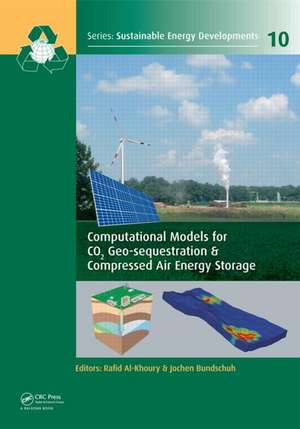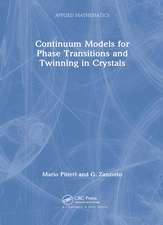Computational Models for CO2 Geo-sequestration & Compressed Air Energy Storage: Sustainable Energy Developments
Editat de Rafid Al-Khoury, Jochen Bundschuhen Limba Engleză Hardback – 17 apr 2014
Energy and environment are two interrelated issues of great concern to modern civilization. As the world population will soon reach eight billion, the demand for energy will dramatically increase, intensifying the use of fossil fuels. Utilization of fossil fuels is by far the largest anthropogenic source of CO2 emission into the earth’s atmosphere. This unavoidable reality necessitates efforts to mitigate CO2 from indefi nitely being emitted in the atmosphere. CO2 geo-sequestration is currently considered to be a vital technology for this purpose. Meanwhile, and as fossil fuels will sooner or later be depleted, utilization of renewable energy resources is inevitable. Nowadays, wind and solar energy, being clean and sustainable, are gaining momentum. However, their availability is intermittent. This intermittent nature of solar and wind energy necessitates storing the produced energy at off-peak times for later use. Compressed air energy storage in subterranean caverns, aquifers and coal seams is currently considered to be a plausible technology for this purpose. CO2 geo-sequestration and compressed air energy storage are thus vital technologies for current and future energy strategy development. These technologies can be made safe and cost-effective by utilizing computational tools capable of simulating the involved multiphysical phenomena and processes. Computational modeling of such systems is challenging and resource-consuming. Meeting such a challenge constitutes the focal point of this book.
This book addresses comprehensive theoretical and computational modeling aspects of CO2 geosequestration and compressed air energy storage. The book consists of 16 chapters authored by prominent researchers in these two fi elds. The authors of the book endeavoured to present years of innovative work, making it available for a wide range of readers, including geoscientists, poromechanists, applied mathematicians, computational geoscientists, geologists and reservoir engineers.
Preț: 1955.37 lei
Preț vechi: 2384.60 lei
-18% Nou
Puncte Express: 2933
Preț estimativ în valută:
374.28€ • 406.69$ • 314.60£
374.28€ • 406.69$ • 314.60£
Carte tipărită la comandă
Livrare economică 21 aprilie-05 mai
Preluare comenzi: 021 569.72.76
Specificații
ISBN-13: 9781138015203
ISBN-10: 1138015202
Pagini: 574
Ilustrații: figures
Dimensiuni: 174 x 246 x 30 mm
Greutate: 1.3 kg
Ediția:1
Editura: CRC Press
Colecția CRC Press
Seria Sustainable Energy Developments
ISBN-10: 1138015202
Pagini: 574
Ilustrații: figures
Dimensiuni: 174 x 246 x 30 mm
Greutate: 1.3 kg
Ediția:1
Editura: CRC Press
Colecția CRC Press
Seria Sustainable Energy Developments
Public țintă
PostgraduateRecenzii
This book [...] is devoted to a detailed presentation of modeling of two particular topics in this vast area, namely CO2 geo-sequestration and compressed air energy storage. The two topics seem at first view quite unconnected, but, as far as modeling is concerned, this is not the case: the basic balance equations of the subsurface system are the same, only some of the involved fluids change. This makes a common treatment in a volume quite suitable because one of the topics may take advantage of methods employed for the solution of the other. The volume contains a foreword by Jacob Bear, one of the giants in multiphase porous media mechanics, who is recently actively involved in CO2 underground sequestration; and sixteen chapters written by thirty-seven experts in their field. Each chapter is self-contained to a certain extent. [...] This volume [...] is first of all most timely and certainly useful for geologists, geophysicists, hydrologists, mining and reservoir engineers, chemical engineers, to mention just a few, and certainly also to computational mechanists who will find there a plethora of useful information.
Bernhard Schrefler, Professor Emeritus, University of Padua, September 2015
Bernhard Schrefler, Professor Emeritus, University of Padua, September 2015
Cuprins
Foreword by Jacob Bear Editors' preface About the editors Acknowledgements 1. Geological CO2 sequestration and compressed air energy storage - An introduction Jochen Bundschuh & Rafid Al-Khoury 1.1 Atmospheric CO2 concentration and mitigation 1.2 Geological CO2 sequestration 1.3 Compressed air energy storage 1.4 Computational modeling PART I: CO2 Geo-sequestration 2. On the theory of CO2 geo-sequestration Mehdi Musivand Arzanfudi & Rafid Al-Khoury 2.1 Introduction 2.2 Definitions 2.3 Averaging process 2.4 Modeling approach 2.5 General balance equations 2.6 Balance equations for special cases 2.7 Constitutive relationships 2.8 Field equations 2.9 Conclusion PART I.I: Reactive transport modeling 3. Modeling multiscale-multiphase-multicomponent reactive flows in porous media: Application to CO2 sequestration and enhanced geothermal energy using PFLOTRAN Peter C. Lichtner & Satish Karra 3.1 Introduction 3.2 Single continuum 3.3 Multiple interacting continua 3.4 Numerical implementation 3.5 Parallelization using the PETSc parallel framework 3.6 Single component system 3.7 Applications 3.8 Conclusion 4. Pore-network modeling of multi-component reactive transport under (variably-) saturated conditions Amir Raoof, Hamidreza M. Nick, S. Majid Hassanizadeh & Christopher J. Spiers 4.1 Introduction 4.2 Pore-network modeling 4.3 Well-bore cement degradation 4.4 Saturation dependent solute dispersivity 5. Reactive transport modeling issues of CO2 geological storage Tianfu Xu & Liange Zheng 5.1 Introduction 5.2 Model description 5.3 Fate of injected CO2 5.4 Impact on the groundwater quality 5.5 Modeling issues 5.6 Conclusions PART I.II: Numerical modeling 6. Role of computational science in geological storage of CO2 Mojdeh Delshad, Reza Tavakoil & Mary F. Wheeler 6.1 Introduction 6.2 Compositional flow model 6.3 Thermal energy equation 6.4 Geochemistry model 6.5 Petrophysical property model 6.6 Computational results 6.7 Ensemble kalman filter history matching methodology 6.8 Summary and current extensions 7. A robust implicit pressure explicit mass method for multi-phase multi-component flow including capillary pressure and buoyancy Florian Doster, Eirik Keilegavlen & Jan M. Nordbotten 7.1 Introduction 7.2 Physical background 7.3 The impem algorithm 7.4 Motivation for the discretization 7.5 Comparison of different approaches 7.6 Concluding remarks 8. Simulation of CO2 sequestration in brine aquifers with geomechanical coupling Philip H.Winterfeld &Yu-ShuWu 8.1 Introduction 8.2 Simulator geomechanical equations 8.3 Simulator conservation equations 8.4 Discretization of single-porosity simulator conservation equations 8.5 Multi-porosity flow model 8.6 Geomechanical boundary conditions 8.7 Rock property correlations 8.8 Fluid property modules 8.9 Example simulations 8.10 Summary and conclusions 9. Model development for the numerical simulation of CO2 storage in naturally fractured saline aquifers Jim Douglas, Jr., Felipe Pereira & Celestin Zemtsop 9.1 Introduction 9.2 The single porosity problem 9.3 Homogenization 9.4 Thermodynamics 9.5 Numerical simulations and results 9.6 Conclusions 10. Coupled partition of unity-level set finite element formulation for CO2 geo-sequestration Rafid Al-Khoury & Mojtaba Talebian 10.1 Introduction 10.2 Governing equations 10.2.1 Equilibrium equations 10.3 Mixed discretization scheme 10.4 Verifications examples 10.5 Conclusions PART I.III: Aquifer optimization 11. Optimization and data assimilation for geological carbon storage David A. Cameron & Louis J. Durlofsky 11.1 Introduction 11.2 A-priori optimization of well placement and control 11.3 Data assimilation and sensor placement 11.4 Aquifer model definition 11.5 Results - a-priori well placement and control optimization 11.6 Results - optimal sensor placement and data assimilation 11.7 Concluding remarks 12. Density-driven natural convection flow of CO2 in heterogeneous porous media Rouhollah Farajzadeh, Bernard Meulenbroek & Johannes Bruining 12.1 Introduction 12.2 Density-driven flow in heterogeneous media 12.3 Analytical model for density-driven natural convection flow 12.4 Summary 12.5 Appendix 12a. Numerical solution of the equations PART II: Compressed air energy storage 13. An introduction to the compressed air energy storage Reinhard Leithner & Lasse Nielsen 13.1 Introduction 13.2 Fundamentals of compressed air energy storages 13.3 CAES-cycles - operated and planned 13.4 Summary 14. Simulation of an isobaric adiabatic compressed air energy storage combined cycle Lasse Nielsen, Dawei Qi, Niels Brinkmeier, Andreas Hauschke & Reinhard Leithner 14.1 The ISACOAST-CC concept 14.2 Simulation models 14.3 Simulation results 14.4 Summary 15. Rigorous process simulation of compressed air energy storage (CAES) in porous media systems Lehua Pan & Curtis M. Oldenburg 15.1 Introduction 15.2 Background 15.3 Methods 15.4 Example PM-CAES simulation 15.4.1 A note on time steps 15.5 Conclusions 16. Detailed system level simulation of compressed air energy storage Siddhartha Kumar Khaitan & Mandhapati Raju 16.1 Introduction 16.2 Background 16.3 Caes plant operation 16.4 Component modeling 16.5 Modeling Huntorf CAES plant: A case study 16.6 Conclusions Subject index
Notă biografică
Rafid Al-Khoury Delft University of Technology, The Netherlands; Jochen Bundschuh University of Southern Queensland (USQ).
Descriere
This book addresses two distinct, but related and highly important geoenvironmental applications: CO2 sequestration in underground formation, and Compressed Air Energy Storage (CAES). Sequestration of carbon dioxide in underground formations is considered an effective technique and a viable strategy for the mitigation of global warming and climate change. However, the short-term and long-term consequences of such an operation might be catastrophic if the involved hydro-chemo-physical and mechanical processes at the regional level are not properly addressed. Compressed air energy storage is a relatively new field of geoenvironmental application, but gaining a lot of momentum due to its effective utilization for energy storage. Renewable energy sources, such as wind energy, can be efficiently stored in the form of a compressed air in underground formations at off-peak times, and re-utilized upon demand. However, pumping and releasing compressed air can cause hydromechanical effects on the region, causing subsidence, upheaving and minor earthquakes. Considering the great potentials of these two geoenvironmental applications and their consequences, it is vital to model the involved flow processes and develop numerical tools, which are capable of describing such processes in an accurate, stable and computationally efficient manner. This book aims at attaining such models and numerical tools.



























